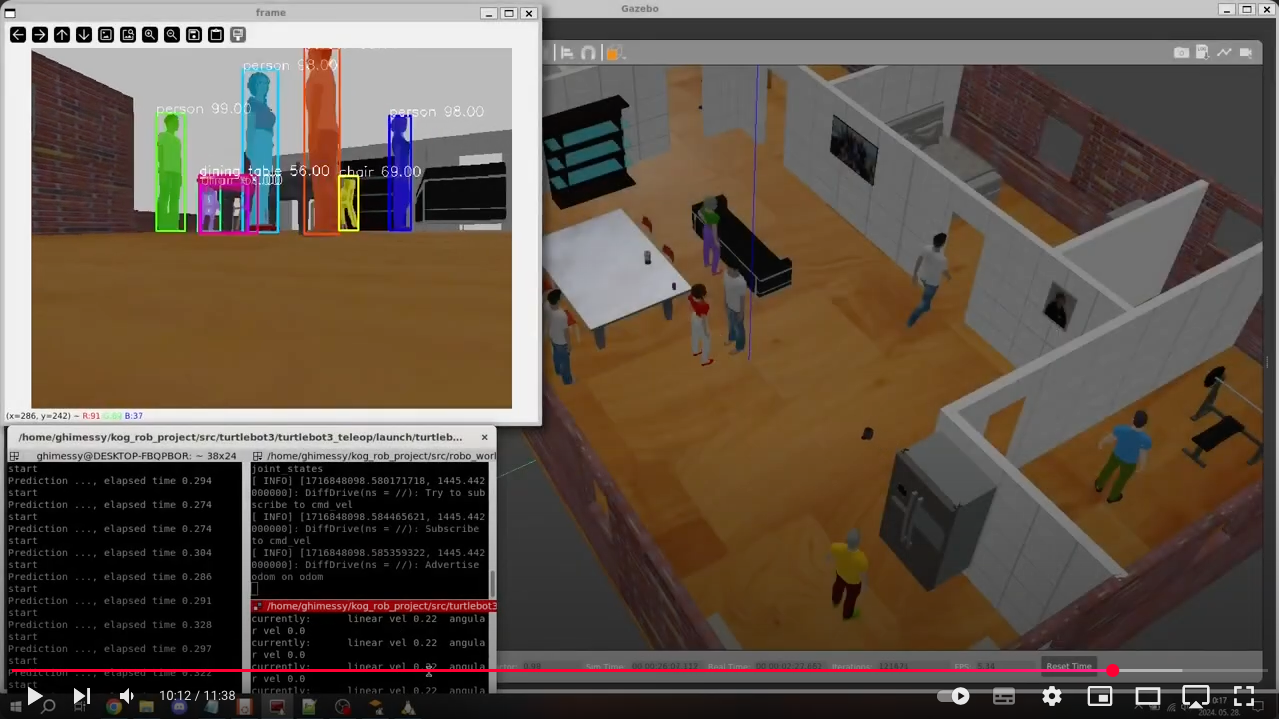Week 1-8: Cognitive robotics
This is how far we will get by the end of this lesson:

Here you can see a short video about the final projects from the previous years:

Table of Contents
- ROS basics
- Gazebo basics
- Turtlebot3 simulation
- Test on the real Turtlebot3
- Turtlebot3 MOGI
- Line following
- Neural network
- Test on the real robot
ROS basics
What is ROS(2)?
ROS, or Robot Operating System, is an open-source framework designed to facilitate the development of robotic applications. It provides a collection of tools, libraries, and conventions that simplify the process of designing complex robot behaviors across a wide variety of robotic platforms.
ROS was initially developed in 2007 by the Stanford Artificial Intelligence Laboratory and continued by Willow Garage, with the goal of providing a common platform for research and development in robotics. The primary motivation was to create a standard framework that could support a broad range of robotic applications, promote code reuse, and foster collaboration within the robotics community.
Key reasons for ROS development include:
-
Standardization: Creating a common platform that simplifies the integration of different hardware and software components.
-
Modularity: Enabling the development of modular and reusable software components (nodes) that can be easily shared and adapted for various robotic systems.
-
Community Collaboration: Encouraging collaboration among researchers and developers, resulting in a vast collection of tools and libraries.
Transition to ROS 2
ROS 2 was developed to address the limitations of ROS 1 and meet the growing demands for industrial and commercial robotics applications. The development began around 2014 and aimed to enhance the capabilities of ROS, particularly in areas such as security, real-time performance, and support for multi-robot systems. In practice, the biggest difference is in the underlying middleware, ROS1 uses a custom transport layer and message-passing system that was not designed for real-time or distributed applications (see ROS1’s roscore).
The latest ROS1 release is ROS Noetic which was intended to be used on Ubuntu 20.04. It goes to EOL in May, 2025 together with Ubuntu 20.04.
Required softwares
Ubuntu 24.04 LTS
In the course we'll use ROS2 [Jazzy Jalisco](https://docs.ros.org/en/jazzy/index.html), which requires Ubuntu 24.04 for the smoothest operation.
You have a couple of options, but the most recommended is the native installation of the operating system - external SSD, dual boot, etc.
1) Native install, the most recommended way. You will learn how to set up the environment, there won't be difficulties with GPU acceleration and many more advantages.
2) Windows 11 WSL2 (Windows Subsystem Linux), see [instructions](https://documentation.ubuntu.com/wsl/en/latest/guides/install-ubuntu-wsl2/). It's a straightforward way if you want to use within Windows environment. You can still learn how to set up the environment but can be more challenging with GUI applications and 3D acceleration.
3) Virtual machine, VMware fusion is [now free for personal use](https://blogs.vmware.com/teamfusion/2024/05/fusion-pro-now-available-free-for-personal-use.html). Less flexible than WSL2 on Windows 11 but works well on macOS. 3D acceleration can be challenging.
4) Docker container. First it might look an easy way to use any ROS distribution on any host operating system, but it's getting more and more challenging if we need GUI applications, 3D acceleration and can be confusing for beginners how to work within the container. You might miss some important experience with setting up the environment if using a pre-configured container image. I only recommend this way for experienced Docker users.
5) Using an online environment e.g. [The Construct](https://www.theconstruct.ai). It looks promising that you don't have to install any special software, but you won't gain experience with setting up the environment. It can be difficult to cherry pick the software versions you need and accessing GUI applications through the web interface is a poor experience.
The options 1 and 2 are the most practical and preferred ways to use ROS. In an exotic case, if you want to run Ubuntu 24.04 and ROS2 Jazzy on macOS and Apple silicon [this](https://www.youtube.com/watch?v=kDosGTdwqO0) is a very good tutorial.
>Pro tip if you want to mount directories from your host system into your guest Ubuntu 24.04 running in VMware fusion, more details [on this link](https://www.liquidweb.com/blog/create-vmware-shared-folder/):
>
```bash
>/usr/bin/vmhgfs-fuse .host:/BME/ROS2-lessons /home/david/ros2_ws/src/ROS2-lessons -o subtype=vmhgfs-fuse,allow_other
>
```
Visual Studio Code
The recommended code editor during the course is [Visual Studio Code](https://code.visualstudio.com/docs/setup/setup-overview), but it's up to your choice if you want to go with your different editor. Depending on your Ubuntu install method you might install it natively on Ubuntu, in your virtual environment or on your host operating system.
File truncated at 100 lines [see the full file](https://github.com/mogi-ros/week-1-8-cognitive-robotics/tree/main/README.md)










